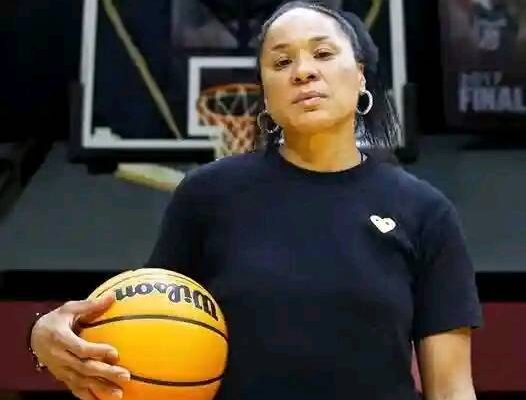Dawn Staley Surpasses Diana Taurasi: The Greatest College Women’s Basketball Player of All Time
In the rich history of college women’s basketball, two names have often been at the forefront of discussions about greatness: Diana Taurasi and Dawn Staley. Both players have left indelible marks on the game, captivating fans with their talent, leadership, and competitive fire. Recently, an ESPN report proclaimed that Dawn Staley has now surpassed Diana Taurasi as the greatest college women’s basketball player of all time. This assertion, while bold, is supported by a thorough evaluation of Staley’s collegiate achievements, impact on the sport, and her legacy both on and off the court.
Before delving into why Dawn Staley might now be considered the greatest, it is essential to understand the impact Diana Taurasi had on college basketball. Taurasi played for the University of Connecticut (UConn) Huskies from 2000 to 2004, a period during which she established herself as one of the most prolific scorers and fierce competitors the game has ever seen.
During her tenure at UConn, Taurasi led the Huskies to three NCAA championships (2002, 2003, 2004), showcasing her clutch scoring and relentless work ethic. She holds numerous UConn records, including points scored and assists, and she was named the National Player of the Year multiple times. Her scoring ability was unmatched, blending a smooth shooting stroke with aggressive drives and a competitive edge that made her a nightmare for opposing defenses.
Taurasi’s collegiate career was defined by scoring prowess, leadership, and a championship pedigree. Her dominance on the offensive end and the team success she helped engineer have made her a legendary figure not only at UConn but across women’s basketball.
Dawn Staley’s collegiate career took place a decade before Taurasi’s dominance, from 1988 to 1992 at the University of Virginia (UVA). Staley’s influence on the game transcends mere statistics — she was the epitome of leadership, defensive tenacity, and court vision. Unlike Taurasi, whose legacy centers on scoring, Staley was a complete player, known as much for her tenacity on defense and ability to orchestrate the offense as for her scoring.
During her time at UVA, Staley led the Cavaliers to three Final Four appearances (1989, 1990, 1992) and an appearance in the NCAA championship game in 1991. Her steady leadership propelled UVA into the national spotlight as a perennial contender in women’s college basketball. Staley’s impact is often described in terms of intangibles — her fierce competitiveness, leadership, and the way she elevated the play of those around her.
Staley was a three-time All-American, the ACC Player of the Year twice, and left UVA as one of the all-time leaders in points and assists. Beyond statistics, her ability to control the pace of the game and defend the opposing team’s best player made her a formidable force. She was an early pioneer in demonstrating that women’s basketball demanded elite basketball IQ and leadership on par with any sport.
The debate over who is the greatest college women’s basketball player of all time is complicated by the different eras in which Staley and Taurasi played. The game evolved significantly between the late 1980s and early 2000s, with changes in style of play, athleticism, training, and exposure.
In Staley’s era, women’s basketball was gaining national recognition but had yet to reach the widespread visibility and dominance that programs like UConn would eventually command. The athleticism and depth of talent in the college game have grown considerably, as have the resources available to players. Staley’s success in a less developed era of women’s basketball, where raw skill and leadership were critical to elevating the sport, highlights her role as a trailblazer.
On the other hand, Taurasi’s achievements came at a time when women’s basketball was entering a golden era of talent and competition. The UConn program, under Coach Geno Auriemma, became a juggernaut, and Taurasi was a cornerstone of their sustained dominance. Her ability to shine in this more competitive and visible environment speaks to her exceptional skill and adaptability.
Thus, any evaluation of “greatness” must consider not only statistics and championships but also the context in which these athletes competed and how they impacted the game beyond their personal accolades.
The ESPN report highlighting Staley’s rise over Taurasi as the greatest college player centers on several key arguments:
Dawn Staley’s leadership was a cornerstone of her college success and remains a defining feature of her legacy. While Taurasi was unquestionably a leader on the court, Staley’s influence extends beyond individual talent. She was the player who embodied what it meant to be a team-first competitor, uplifting those around her and setting an example for professionalism and dedication.
Her leadership helped transform Virginia into a national powerhouse during an era when the program was not traditionally a blue blood in women’s basketball. This transformation demonstrates the kind of impact that goes beyond stats and championships.
Moreover, Staley’s post-college career as a coach and mentor has further solidified her legacy. She has been a transformative head coach at the University of South Carolina, leading the Gamecocks to multiple NCAA championships and becoming one of the most respected figures in women’s basketball. This ongoing influence arguably begins in her college career and strengthens her claim as the greatest.
One of Staley’s defining traits was her defensive prowess. While Taurasi is often celebrated for her scoring, Staley was equally feared for her lockdown defense. She was a tenacious on-ball defender who could shut down the opposing team’s best perimeter player. Defense is often undervalued in discussions of greatness, but Staley’s ability to impact both ends of the court makes her a more complete player.
In an era before the widespread embrace of advanced analytics, Staley’s defensive impact was seen and felt by teammates, coaches, and opponents alike. This kind of two-way excellence is rare and elevates her above many great offensive players.
Staley’s style of play was defined by her exceptional basketball IQ and versatility. As a point guard, she orchestrated the offense, made her teammates better, and was adept at reading defenses. Her ability to pass, score, defend, and lead in high-pressure situations made her a uniquely complete player.
This level of versatility and mental acuity often gets lost when comparing raw statistics but is crucial to understanding her overall impact on the game. Staley’s basketball mind is often cited as one of the best in the history of women’s basketball, a factor that continues to influence her success as a coach.
Dawn Staley’s legacy is not confined to her college years. She has been a pivotal figure in growing women’s basketball at every level—from international competition to professional leagues to coaching. Her career spans decades, and her consistent excellence and advocacy for the sport have elevated her status to that of a true icon.
The ESPN report suggests that Staley’s ongoing contributions to the sport enhance her standing as the greatest college player, as her influence is inseparable from her time at UVA. In contrast, while Taurasi’s professional career is legendary, it is Staley’s all-encompassing impact that resonates most profoundly in the collegiate context.
Greatness in sports is often defined by a combination of skill, accomplishments, leadership, and legacy. Both Dawn Staley and Diana Taurasi embody these qualities in extraordinary ways.
Taurasi redefined scoring and clutch performance at the college level and has continued that excellence into the professional arena, becoming the WNBA’s all-time leading scorer and an Olympic gold medalist. Her offensive brilliance and competitive fire make her one of the greatest players in women’s basketball history.
Staley, meanwhile, represents a holistic vision of greatness—someone who dominated her era through leadership, defense, and intellect, and who has continued to shape the sport through coaching and advocacy. Her story is one of breaking barriers, mentoring the next generation, and embodying excellence both on and off the court.
The ESPN report recognizing Dawn Staley as the greatest college women’s basketball player of all time invites fans and analysts to reconsider how we define greatness. It challenges the notion that individual scoring and championships alone dictate the title of “greatest” and emphasizes the broader impact a player has on the sport and their community.
While Diana Taurasi’s accomplishments are legendary and her impact undeniable, Dawn Staley’s leadership, defensive mastery, versatility, and lasting influence on the game create a compelling case for her as the greatest college player ever.
In the end, both athletes have elevated women’s basketball to new heights and serve as inspirations for future generations. Staley’s surpassing of Taurasi in this debate is less about diminishing one icon and more about celebrating the multifaceted nature of greatness in women’s college basketball.



